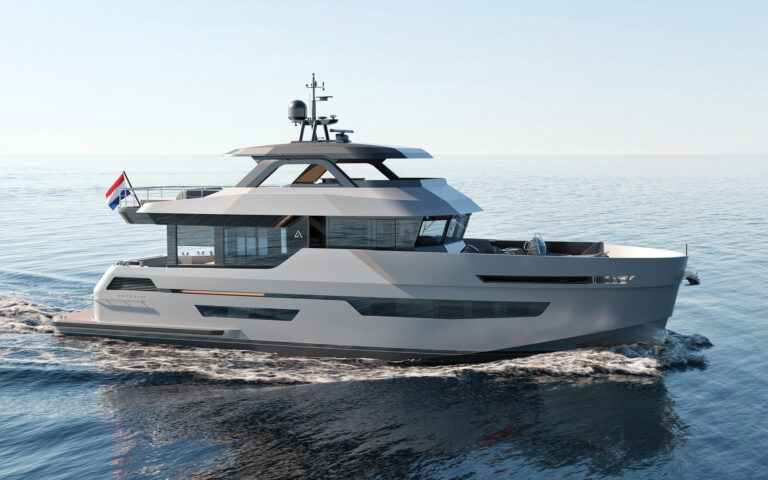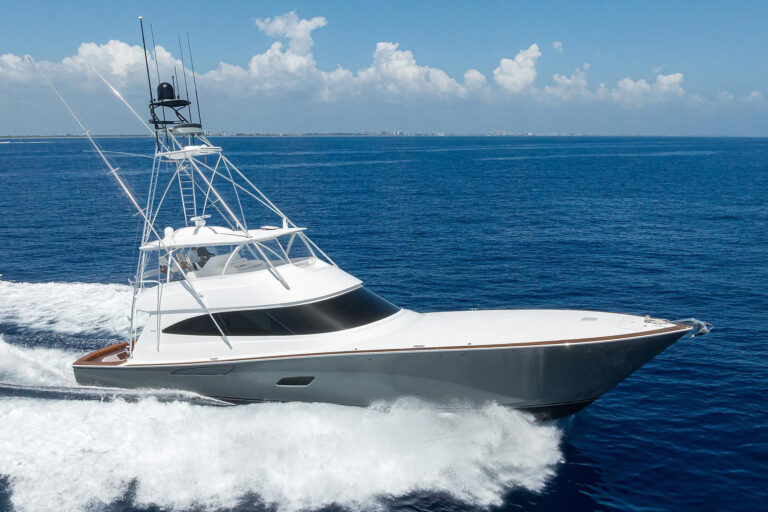The 80 Voyager is the largest offering from Offshore, but more than her size sets her apart from her 52- to 66-foot siblings. The 80 represents a culmination of what the company has learned building more than 250 yachts. She is a serious little yacht of sound design intended for yachtsmen looking to head out on an extended voyage, and she builds on the company’s heritage with design and construction details well-suited to her mission.
She has a lineage that would put a Kentucky Derby winner to shame. During World War II, Richard Hunt was one of the pioneers of a newfangled material called Fiberglass Reinforced Plastic, which we’ve shortened to fiberglass. After the war clouds passed, Hunt started building the earliest laminated fiberglass pleasure boats. His sons joined the business in the late ’50s, when the first Offshore 40s were imported. In the late ’60s, naval architect Bill Crealock, well known for his world cruising designs, began a long collaboration with the Hunts, bringing the seakindly hulls and handsome lines that have led to the 80 Voyager.
Her ride is a result of Crealock’s deep forefoot tapering gently to a 12-degree deadrise at the transom, giving her speed and a pleasant motion. I didn’t get a chance to give her a proper run-through, but my time aboard made me believe her long keel will provide form stability as well as good tracking in all sea conditions. With the propellers tucked into prop pockets, the keel and skeg also protect the props-an important feature in a yacht meant for serious cruising. The 5-foot, 2-inch draft allows shallow-water exploring in the Bahamas and Mexico’s Sea of Cortez.
Equipped with a pair of 800 hp Caterpillar 3406E diesels, her cruising range is 2,200 miles at 8.5 knots, according to the builder. She cruises at 13 knots with a top end of 15.7, also according to the builder.
Construction is superb, with solid laminate below the waterline in the one-piece hull and closed-cell in the topsides and superstructure for stiffness and light weight. Vinylester resin prevents blisters. Husky stringers and athwartships frames are laminated and bonded to create a hull of exceptional strength. This yacht is overbuilt for peace of mind offshore. Not only is the tooling detailed (planking seams accent the deck overheads), but all of the fiberglass is incredibly fair and the hull has a mirror-like finish.
Yacht-like details are also well done. Take the drains for the main and boat decks. Most traditionally styled yachts mold a notch in the rail and let the water run off the deck, where it leaves long, dirty streaks down the topsides. On the 80, water drains internally to the waterline, so there won’t be the usual dirt stripes.
Since the 80 is intended to be a voyager, she has oversized freeing ports, as well, to dump large amounts of green water overboard quickly.
Also take a close look at the window frames, an area most owners don’t notice until their aluminum frames have corroded into a gray crustiness. On the 80, the window frames are part of the mold for the fiberglass superstructure, so they won’t corrode like aluminum or rot like wood.
The covered afterdeck, with easy access via twin stairs from the wide boarding platform, is fitted with a pair of teak tables with intricate inlays. The settee across the transom conceals a fuel tank for the tender, an overlooked detail on many cruising yachts.
The saloon is arranged to suit each client. Our test boat had a wraparound sofa to starboard, a comfortable recliner to port and a large television in the after port corner. The cherry paneling had a strong grain pattern, accented by cherry burl used for the countertops. The recessed panel design is truly recessed, not faked with moldings.
An entry foyer spans the beam, with the day head to port and stairs to starboard flowing down to the master suite. Just forward, the galley includes a Sub-Zero refrigerator, two under-counter Sub-Zero freezers, and a working area designed for minimum movement. The cooktop is aft, sinks are opposite in a granite counter, and there is a pass-through in the forward bulkhead that can be closed for privacy. All of the lockers have sliders for easy access, and all of the china and glassware fits snugly into dedicated stowage racks.
The forward section of the house is used as a dining room and lounge area that is likely to be a gathering place while under way. A curved banquette is forward behind a dining table and four chairs, while a pair of bar stools faces the raised onyx counter aft.
Stairs from the lounge lead to the two guest cabins, with a queen island berth in the forward cabin and, on this yacht, a double and a single in the larger after cabin, which can be fitted with a variety of bedding choices. The heads in both cabins have oversized molded showers, marble counters and Tecma turbo flush heads.
Down from the entry foyer is the master stateroom, which takes full advantage of the 20-foot, 6-inch beam amidships for the least motion. A king berth is on centerline. A built-in seat is to starboard, a vanity is to port, and frosted French doors lead to the two separate heads. A his-and-her head separated by a shower or bathtub will be built into future 80s.
Crew quarters are aft, finished as well as the rest of the yacht, with a double stateroom to port and a lounge area with mini-galley. The lazarette is as big as that on many 120-footers, with a stainless-steel work counter and stowage for tools, fishing gear and water toys.
Unnoticeable but important, every living area on the lower deck has an emergency access hatch. The owner’s cabin opens into a foyer that has a watertight door into the engineroom, as well as stairs leading directly to the port deck.
The sides of the cabin house are tucked inward to create a wasp-waisted look that is as successful as it is clever. Not only does it provide two forward-facing windows on each side of the saloon to allow views unavailable on other yachts, but it permits the two doors to be left open for ventilation-even when the yacht is under way. The boat deck covers the side decks, providing protection from rain in cold climates and shade in the tropics.
The pilothouse is everything you would expect on a comfortable cruising yacht, providing the perfect perch for long passages. Features include three Stidd helm chairs, superb 360-degree visibility, a settee aft to starboard, and a chart table/ship’s office to port. Each owner chooses his own electronics package, and the factory runs the wiring and installs the hardware, with the connections and testing completed when the yacht is delivered.
Directly abaft the pilothouse is the boat deck, which, on this boat, had upgraded twin settees. A 2,500-pound crane easily handled the 16-foot Novurania tender, and the outside entertainment amenities included a grill, refrigerator and sink.
Like the rest of the 80, the engineroom screams voyaging. Often overlooked details include full-flow stainless-steel ball valves on the piping, gate valves linking each watertight structural bulkhead to control the flow of bilge water, integrated outlets for the air compressor, and start/stop panels for each engine with complete gauges. Recognizing that keeping fuel clean and managing consumption are the most crucial components for bluewater cruising, Offshore fitted the fuel filters with vacuum gauges, so owners can spot a blockage easily.
The engineroom is finished with Treadmaster-covered walkways around the twin 800 hp Caterpillar 3406E diesels. A pair of Northern Lights generators (32kW and 20kW) is aft in sound shields. One interesting feature is the battery system that includes four alternators (two per engine) and a pair of Trace 4kW inverter/chargers that, with 16 gel-cell batteries, can easily run the ship’s systems (including the refrigeration) without needing the generators, conserving fuel and increasing range.
One of the pleasures of a yacht like the Offshore 80 Voyager is that the longer you stay aboard, the more you appreciate the thoughtful and seamanlike attention to details. This is a yacht for an owner who knows and understands quality.
Contact: Offshore West, (619) 688-0574; osyachts@sbcglobal.net. Offshore East Yacht Sales, (954) 779-1021; offshoreeast@cs.com; www.offshoreyachts.net.









